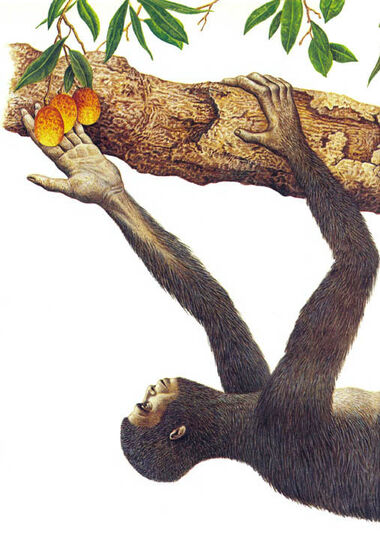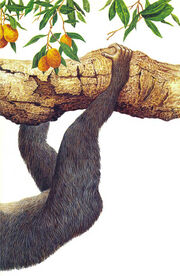
The tree-dweller, Arbranthropus lentus, is an arboreal, tree sloth/gibbon-like descendant of the tropical tree-dweller, from 3 million years (the 30020th Century), from Man After Man: An Anthropology of the Future.
The long hooked fingers evolved to cling to the jungle canopy, but they can also break open insect nests under the bark. Small but slow, the tree-dweller moves with deliberation through the humid rainforest, clinging tightly to the underside of the great spread of branches. Fruit is plentiful and insects abound. With no enemies and abundant food there is no need for speed, aggression or change. Without the need to adapt or develop, the tree sloth-like tree-dweller will remain in a state of stasis, able to breed but unchallenged.
A small ape moves slowly, upside down, through the dripping branches of the tall trees. Her fingers and toes are permanently curved, and allow her to hang on the underside of the stoutest branches.
Slowly she turns her little head and looks about, seeking out the next piece of food growing in the humid air. There, on the next tree, is a bunch of fruit. Carefully she crawls along beneath the branch back to the trunk, where she can

The hand has evolved two strong fingers that allow the tree-dweller to hang from the underside of branches.
climb out amongst the branches closer to it. Dimly she sees that there is another creature, a male of her own kind, already on that tree, well above the branch with the fruit. He is moving slowly downwards. Whoever reaches the fruit first will claim it. Her long fingers reach for the next handhold, and splinter through a weak thin layer of bark. The air is suddenly full of noise and aggression. A cloud of insects has burst from the hole and is thudding into her, jabbing through her pelt with pointed tail weapons. She feels the prick of the attacks, but there is no pain, as her line became immune to the poisons generations ago. She knows that there is good eating here, so ignoring the insects that are swarming and clustering around her hands she breaks up the bark covering the nest that she has disturbed. Combs of honey an

d grubs are stacked in there, vertically in neat rows. With her usual deliberate actions she breaks them from their hollow and chews contentedly.
Afterwards, with the nest empty, and the insects spent, exhausted or fled, she remembers the fruit on the next tree. With painfully slow movements she unwinds from her feeding position and begins to crawl along the branch once more.
Eventually she comes in sight of it, but she is too late. The male has already reached it and is eating. No worry. She has fed, and there is plenty of other sustenance around. She turns to crawl away again; but then she stops because the male has noticed her and is crawling along the underside of the thin branches towards her.
He obviously wants to mate. Does she want to let him? Yes, this is a good time since they have both eaten and will have the energy. It is also a long time since she gave birth, and her child has now matured and left, so she can take on the responsibility once more. Meekly she awaits the male's approach.
The rainforests that still clothe the windward mountains of the moister parts of the globe and the great river basins along the Equator still have the lineage of the original tropical forest-dwellers (now the tree-dwellers), which in most places have changed little over the millennia. The long arms and long-fingered hands that grasp branches allow them to hang firmly onto their high perches. The long legs with the prehensile toes allow trunks and boughs to be negotiated. The weak intellect that knows only about food and mating, and about those only enough to satisfy the basic drive for existence, allows the creature to survive. Food has always existed here, and, seemingly, will do so forever; therefore the tree-dwellers have no need to change, unlike the creatures indigenous to the other habitats of the world.
The only change has occurred in the pace of their lives. With no enemies, the tree-dwellers in many areas have become slow and ponderous, moving sluggishly from one meal to the next, from one mate to another. There is no strife, either with one another or with different types of creature. Perhaps someday, when something unforeseen comes and takes away the forest, then perhaps the tree-dwellers will alter. That is, if they still have the genetic capacity for adaptation, if they have not lost the inherent ability through a long period of stasis and inbreeding.
Any change to the environment, however, will not take place for a long time yet.
By 5 million years (the 50020th Century)[]
The moving stars have come. The sluggish tree-dwellers in the trees of the forests can comprehend nothing higher than the tops of the trees that they inhabit. Nor do they need to, all their food existing to hand in their own environment. Nothing outside can have any effect on them.
Decades later, they are wiped out by the travelers of the stars.
